-
Recent Lessons
- Keith Haring Murals in San Sebastián
- Keith Haring Murals
- Come To Know Keith Haring
- Organ Systems Mural
- City as Canvas: Artist Spotlight
- Printing with Objects
- Mural Making in the Style Of Keith Haring
- Subway Graffiti Project
- T-shirt Designer
- Keith Haring Semiotics Poster
- Introducing Keith Haring
- Discovering Keith Haring
- Haring Inspired Mural
- All Bottled Up!
- Thinking about Drawings as Symbols
More Resources
Recent Comments
- Daniel Wiener on Symbols & Signs
- Victoria E Sylvestre on Symbols & Signs
- Emoji: Modern Symbol Communication | OH THE ART PLACES WE CAN GO on Thinking about Drawings as Symbols
- coco on Keith Haring Biography
- Crack is Wack II | Muros hablados on Studying Mural: “Crack is Wack”
Curriculum: Math
RNA Protein Strand Sculpture
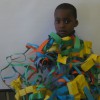
Students utilize elements of design to compose a work of art
(Making a Box) Vocabulary: 3-D, Volume
(Building a 3-D structure from the 2nd Dimension)
Realizing the (RNA Protein Structure)
Hip to be Square
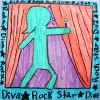
After looking at works from Keith Haring's "Dance" book, 3rd grade students use a square piece of paper to design their own Keith Haring dance composition. Using markers, they outline and color in their shapes solidly like Keith Haring's paintings
Remote Control Grid Drawings
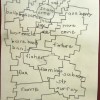
Students follow my step by step example of an abstract drawing. I do and then they do.
The idea is to see how similar we can make the same drawing focusing on placement and scale.
This made possible by utilizing the simple understanding of point, line, and middles using the grid.
Jumping Kids Art
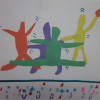
Our 2nd graders did a fabulous job as they created these amazing pictures in the style of Keith Haring. We learned how to draw basic body shapes in proportion by drawing ovals. We drew an oval for the head, a bigger oval for the body, 3 smaller ovals for each arm, and then 3 ovals for each leg. We learned that our body only bends where we have a joint... in this case where two of our ovals met. We drew people doing all kinds of fun things. Ideally, the children drew figures doing something that was important to them... something they loved. Then we cut out our figures and glued them down. We tried to overlap the figures to show depth. This was a hard concept for the children to understand, but it was really interesting to see the results. Finally, we created some visual texture by making a beautiful patterned floor for our figures to dance on. I love the energy in all of these pictures. In the 2nd picture especially, you can actually see the children playing basketball. The overlapping in this piece of artwork provides so much depth to the picture.
Morphing
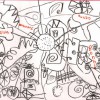
With an emphasis on line, this lesson explores the potential of a collaborative process by conitnually redefining the drawing as a piece of work as well as a process.
Ten
Using Keith Haring's book, TEN as a starting point, children will learn to quantify and visually depict numbers.
Drawing Movement
This local New York City school used Keith Haring's art to inspire a lesson on expressing movement in drawing.
Haring All Over
A lesson that focuses on pattern and design through line and color. The teacher, a fellow Haring fan, used many of the images on our site to inspire her students. The finished products were photographed and made into a book.
The Tarpaulin Project
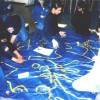
A lesson that practically guarantees great results AND a low budget! The Tarpaulin Project was developed by the Education Staff at the Art Gallery of Ontario in an effort to help students become more familiar with Keith Haring's work and working methods while cultivating students' ability to express emotions on a visual level.
Symbols to Sculptures
Designed by the Museum Educators at the Art Gallery of Ontario in Toronto, Canada, this lesson encourages students to consider shapes as a construct for symbol making. The project proposes a transformation from 2-dimensional drawings to synthesized, 3-dimensional forms.
Pop Shop 4 – Shopkeeping
Create and run a store to sell prints, pictures, tee shirts created in Pop Shop Lessons 1 - 3.
Crayon Rubbing Flip Book
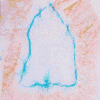
THIS LESSON USES THE NYC BLUEPRINT LEARNING STANDARDS.
This flip book lesson is designed to make learning about animation a more tactile, fun experience for young learners by eliminating tracing and bringing the line to life. Students will use their hands to gradually bend and reshape a line (floral wire), while recording this experience using crayon rubbings. The sequential crayon rubbings will become frames for their flip book.
This lesson is originally designed to accompany a math lesson about closed shapes, giving students an experience with the formation of flat sides, curves, and angles.